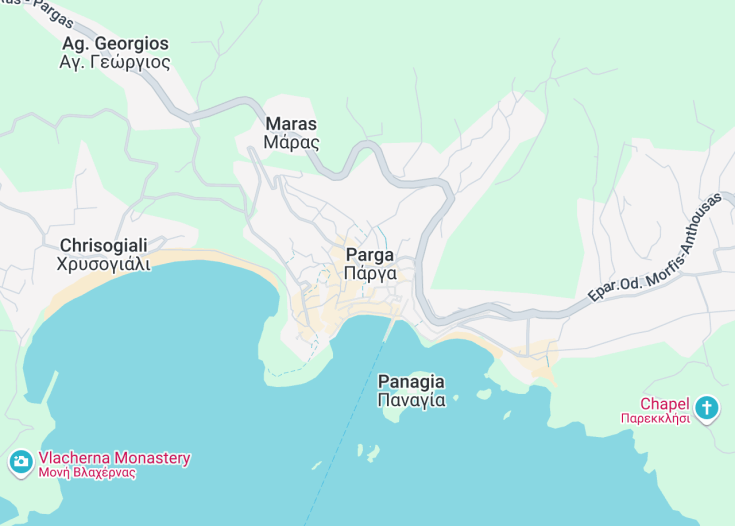Parga, a picturesque town located in the northwest of Greece, enchants visitors with its blend of natural beauty and historical charm. Nestled between lush hills and the Ionian Sea, Parga invites exploration with its colorful houses, crystalline waters, and sandy beaches.
The town is renowned for its Venetian castle, which stands as a testament to Parga’s rich past, offering panoramic views of the surrounding olive groves and turquoise sea. Ideal for both relaxation and adventure, Parga provides a perfect escape with its delightful mix of tranquil bays, vibrant local cuisine, and friendly atmosphere.
For an unforgettable experience, visit Parga during the late spring or early autumn to enjoy pleasant weather and fewer crowds, enhancing your enjoyment of this scenic locale.
Don’t miss out on trying Parga’s local delicacies, especially dishes featuring seafood caught directly from the Ionian Sea, for a taste of the authentic regional flavors.
Top things to do & see in Parga
Select the following sights and activities to discover best tickets and tours available in Parga.
Parga: Gateway to Greece’s Picturesque West Coast
| Country | Greece |
| Time in Parga | GMT+2 |
| Language spoken | Greek |
| Population | 2,415 (source: Greece National Statistical Service) |
| Currency | Euro (€, EUR) |
| Airports |
|
Situated on the northwestern coast of Greece, Parga beckons with its blend of vibrant history and stunning Mediterranean landscapes. This coastal town is not just a holiday destination but a venue of historical significance with roots tracing back to ancient Greece. Parga is overshadowed by a picturesque castle perched atop a hill, testament to its strategic importance through Byzantine, Venetian, and Ottoman times.
This castle, with its expansive views of the Ionian coast, narrates tales of ancient sieges and fierce battles. Today, Parga invites tourists to explore its olive-adorned hills and sparkling turquoise waters. Its narrow cobbled streets lined with boutiques, traditional tavernas, and ambient cafes reflect a lively, welcoming community tied deeply to its cultural heritage. Each summer, Parga becomes particularly animated with festivals celebrating everything from music and dance to local cuisine, offering visitors a taste of Greek hospitality and merriment.
Where is Parga?
Parga is nestled on the Ionian coast of the Epirus region, nestled between mountains and sea, providing striking hillside views and clear waters.
Distances:
| Route | Distance by car | Time by car |
|---|---|---|
| Athens to Parga | 219 miles (352 km) | 5 hours |
| Thessaloniki to Parga | 200 miles (322 km) | 3.5 hours |
What is Parga famous for?
Parga is celebrated for its postcard-perfect scenery, historic architecture, and vibrant festivals. Its engaging landscape and cultural heritage make it a standout destination in Greece.
History
Ancient to Medieval Times (Before 13th Century)
The history of Parga commences in ancient times, where it was predominantly a collection of provincial settlements. Throughout the Byzantine era, it grew in prominence due to its strategic coastal position. Parga’s natural fortifications made it a desirable asset for empires and a refuge against piratical invasions.
Venetian Rule (1401-1797)
Parga reached a significant peak during the Venetian rule. The Venetians fortified the city, constructing a castle on a hilltop to protect against the Ottoman threat. This era was marked by prosperity in trade and arts, as Parga became a commercial hub in the Ionian Sea. Its autonomy under the Venetian Republic allowed for a unique blend of cultures and architectures that still characterizes the town today.
Ottoman Threat and British Administration (1797-1819)
The end of the Venetian era brought Parga under the brief control of the French until the Ottomans dominated the region. During this period of turmoil, Parga was a beacon of resistance. In 1819, the British Empire took control, which led to relative stability but also ignited controversies, especially when the British handed Parga over to the Ottomans in exchange for the Ionian Islands.
Modern Era and Tourism (20th Century to Present)
The 20th century was transformative for Parga as it shifted from a strategic military site to a coveted tourist destination. After joining Greece in 1913, Parga gradually developed its infrastructure to support tourism. Today, Parga is celebrated for its stunning landscapes, historical sites, and vibrant culture, making it a prominent fixture in Greece’s tourist itinerary.
Visit Parga
Highlights of Parga
To fully experience Parga, a visit to its iconic Venetian Castle is essential; from its walls, one can capture panoramic views of the Ionian Sea.
Stroll through the narrow, cobbled streets lined with boutique shops, or relax at Valtos Beach, a nearby picturesque spot. The town is also noted for its olive oil production, offering guided tours at local groves and mills.
- Venetian Castle of Parga
- Valtos Beach and Sarakiniko Beach
- Parga’s Olive Oil Museum
- Day trips to the Paxi Islands
Festivals in Parga
Parga hosts a variety of cultural and musical events, particularly vibrant during summer. The Parga Music Festival in August features live music ranging from traditional Greek to contemporary genres. The Panhellenic Festival in September, celebrates Greek heritage with dance, food, and art displays.
Best time to visit Parga
The most favorable time to visit Parga is between late spring and early autumn (May to September) when the weather is sunny and warm, ideal for beach-going and exploring the town’s historical sites.
Is Parga worth visiting?
Parga is undoubtedly worth a visit for those who appreciate a blend of history, culture, and stunning natural beauty. It offers a quaint yet vibrant escape with its rich history embedded in its architecture, the serene beaches, and welcoming local atmosphere.
Parga serves not only as a relaxing retreat but also as a gateway to exploring the broader region of Epirus and the Ionian Islands.










